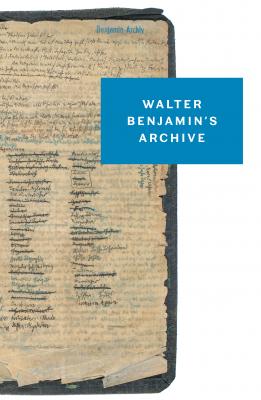Walter Benjamin’s Archive. Walter Benjamin
Чтение книги онлайн.
Читать онлайн книгу Walter Benjamin’s Archive - Walter Benjamin страница 6

Fig. 1.6
Fig. 1.6
Miscellany
An old farmer’s pipe, amber mouthpiece, bowl studded with silver
Photographs: in the large bureau—middle compartment,
small drawer at the bottom on the right
| Heinle brothers’ bequest | in a large marbled rectangularquite flat marbled cardboard boxwhich probably is in one of the cases |
| Heinle brothers’ bequest | several slim notebooks covered in stiff cardboard |
Fig. 1.7
Fig. 1.7
Catalogue of My Published Works
The publications listed here are as follows: his pseudonymous publications for the youth movement magazine Der Anfang [The Beginning]: Sleeping Beauty published in March 1911; The Free School Community from May 1911; the two-part Teaching and Evaluation from May–July 1913; Romanticism from June 1913; Thoughts on Gerhart Hauptmann’s Festival from August 1913; and Experience from October 1913.
Listed also: School Reform, A Cultural Movement, published in a Free Students’ publication on students and school reform in 1912; Moral Education in The Free School Community journal; Youth Was Silent, published in the journal Action in 1913; Aims and Methods of the Student-Pedagogic Groups at the Universities of the German Reich, published in a collection of papers from a student conference in 1914; Students’ Author Evenings published in The Student in 1914; and Erotic Education (On the Occasion of the Latest Students’ Author Evening in Berlin), which appeared in Action in 1914.
Fig. 1.8
Fig. 1.8
Gabriele Eckehard: The German Book in the Baroque Epoch Ullstein, Berlin
It is rare for collectors to present themselves to the public. They hope to be regarded as scholars, connoisseurs, if needs be as owners too, but very rarely as that what they above all are: lovers. Discretion appears to be their strongest side, frankness their weakest. When a great collector publishes the glorious catalogue of his treasures he may be displaying his collection, but only in the rarest cases does he display his genius for collecting. The present book provides a welcome exception from these rules. Without exactly being a catalogue, it showcases one of the most impressive private collections of German Baroque literature. Without exactly being a history of the mode of acquisition of the collection, it contains the impulses out of which it was built. Many love to speak of the “personal relationship” that a collector has to his things. Fundamentally this phrase appears rather designed to trivialize the attitude that it wants to recognize, placing it as tentative, as agreeably moody. It is misleading. + It would be better to characterize the community of genuine collectors as those who believe in chance, are worshippers of chance. Not only because they each know that they owe the best of their possessions to chance, but also because they themselves pursue the traces of chance in their riches, for they are physiognomists, who believe that everything that befalls their items, no matter how illogical, wayward or unnoticed, leaves its traces. These are the traces that they pursue: the expression of past events compensates them a thousandfold for the irrationality of events.—All this is said in order to indicate why it is not just the author of this work but also the collector who is honored, when we designate her a connoisseur of physiognomy. What she records about the binding, the printing mode, the conservation, the price and the distribution of the works with which she deals, are likewise many such transformations of coincidental fate into mimetic expression. To speak of books as she does is the prerogative of the collector. We hope that the example that is given here—right down to the layout and illustrations—is followed by many, unlike the few who preceded.++
Handwritten marginalia:
Top right:
The Lit World
VI, 23
6 June 1930
Handwritten amendments: “laudable” substituted for “welcome”
+ Collectors may be loony—though this in the sense of the French lunatique–according to the moods of the moon. They are playthings too, perhaps—but of a goddess—namely τυχη.
++ That amongst these few, though, the best—Karl Wohfskehl—is a lover of the Baroque shows that, for the true book collector, few similarly adequate objects of his love exist apart from precisely these books stemming from the German Baroque epoch.
Fig. 1.9
Fig. 1.9
A page from Benjamin’s Paris address book of the 1930s.
The names listed here: Margarete Steffin, Mopsa Sternheim, Günther Stern, Ernst Schoen, Ruth Schwarz, Toet Sellier, Max Strauss, Jean Selz, Eliane Simon and Gershom Scholem.
For someone whose writings are as dispersed as mine, and for whom present conditions no longer allow the illusion that they will be gathered together again one day, it is a genuine endorsement to hear of a reader here and there, who has been able to make himself at home in my scraps of writings, in some way or another.
GB IV, p. 394
The card index marks the conquest of three-dimensional writing, and so presents an astonishing counterpoint to the three-dimensionality of script in its original form as rune or knot notation. (And today the book is already, as the present mode of scholarly production demonstrates, an outdated mediation between two different filing systems. For everything that matters is to be found in the card box of the researcher who wrote it, and the scholar studying it assimilates it into his own card index.)
SW 1, p. 456.
Even though Benjamin’s audience was not exactly small in the second half of the 1920s, the difficulties of existence as a freelance author were familiar to him: the necessity to secure money to live on; arising from this the imperative of lobbying editors and publishers; the merciless circuits of acquiring, executing, and delivering commissions; the impossibility of pursuing larger projects, because writing for subsistence money gobbled up all of his time.